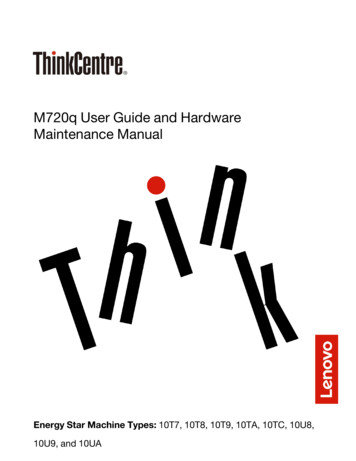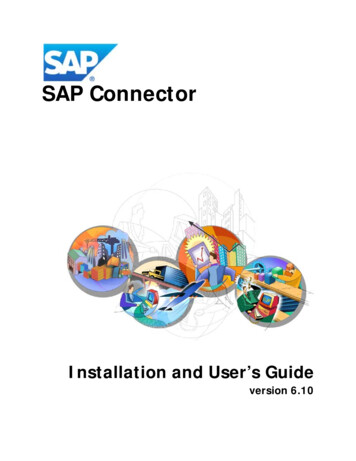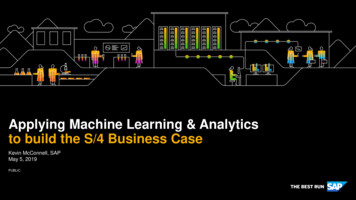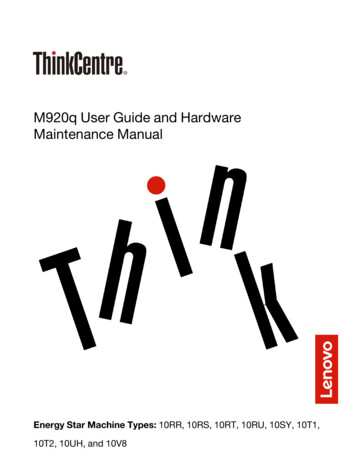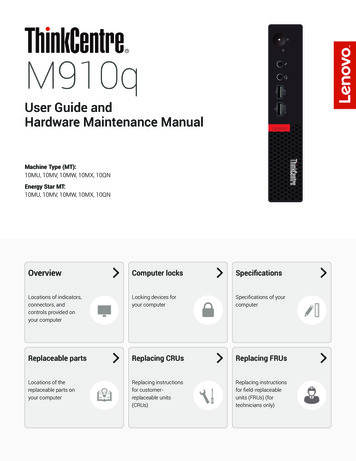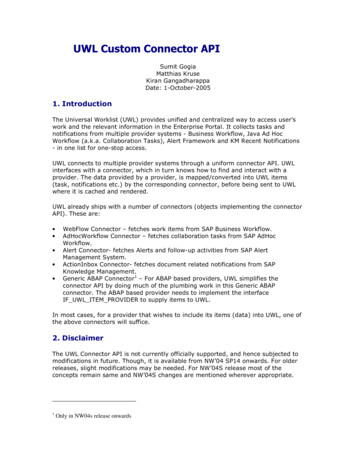
Transcription
UWL Custom Connector APISumit GogiaMatthias KruseKiran GangadharappaDate: 1-October-20051. IntroductionThe Universal Worklist (UWL) provides unified and centralized way to access user’swork and the relevant information in the Enterprise Portal. It collects tasks andnotifications from multiple provider systems - Business Workflow, Java Ad HocWorkflow (a.k.a. Collaboration Tasks), Alert Framework and KM Recent Notifications- in one list for one-stop access.UWL connects to multiple provider systems through a uniform connector API. UWLinterfaces with a connector, which in turn knows how to find and interact with aprovider. The data provided by a provider, is mapped/converted into UWL items(task, notifications etc.) by the corresponding connector, before being sent to UWLwhere it is cached and rendered.UWL already ships with a number of connectors (objects implementing the connectorAPI). These are: WebFlow Connector – fetches work items from SAP Business Workflow.AdHocWorkflow Connector – fetches collaboration tasks from SAP AdHocWorkflow.Alert Connector- fetches Alerts and follow-up activities from SAP AlertManagement System.ActionInbox Connector- fetches document related notifications from SAPKnowledge Management.Generic ABAP Connector1 – For ABAP based providers, UWL simplifies theconnector API by doing much of the plumbing work in this Generic ABAPconnector. The ABAP based provider needs to implement the interfaceIF UWL ITEM PROVIDER to supply items to UWL.In most cases, for a provider that wishes to include its items (data) into UWL, one ofthe above connectors will suffice.2. DisclaimerThe UWL Connector API is not currently officially supported, and hence subjected tomodifications in future. Though, it is available from NW’04 SP14 onwards. For olderreleases, slight modifications may be needed. For NW’04S release most of theconcepts remain same and NW’04S changes are mentioned wherever appropriate.1Only in NW04s release onwards
The RSS Connector detailed in this document and the accompanying code is fordemo purposes only and SAP does not provide support for it.3. How this paper is organizedThis paper is for the cases where a new connector implementation is deemednecessary. A typical example would be integration of third party workflow generateditems. We will walk through the process of writing such a custom connector thatfetches data from a provider (not supported by one of the existing connectors),registering and configuring it with UWL.The rest of the paper is split into the following chapters: Overview – An overview of what we want to accomplish.UWL Connector API – Information about the connector APIImplementing a Custom Connector – Details on implementing our customconnector.UWL Basics – Minimal and necessary background information regarding UWL.RSS Basics – Since our custom connector would fetch RSS feeds (see 4.Overview).4. OverviewAs mentioned in the Introduction, this paper explains the UWL custom connector API,the steps involved in writing a custom connector, and shows what can beaccomplished using the connector API.To make things a little more interesting, we will write a provider which aggregatesRSS Feeds (refer to 8. RSS Basics). It will fetch RSS Feeds from various sourcesfrom the internet and aggregate them. Our custom connector will take these RSSFeeds (from the provider), convert/map them into UWL items and send them over toUWL. Finally we will configure UWL to display our RSS Items under the tasks tab. Wewill also configure UWL, so that certain actions can be taken on our RSS items –complete, delete and show details.The below screen shots capture the gist of what we will do in the following chapters.
5. UWL Connector APIThe following picture illustrates the basic idea.
The important and relevant things for us are the following: A connector implements the IProviderConnector interface and acts as themediator between the UWL Service and the actual Item Provider.An instance of the connector needs to be registered with the UWL Service andshould be co-located with the UWL Service in the same web container. There isno need for the connector to be created remotely. Once registered with UWL, theconnector is called at regular intervals to retrieve items that the UWL renders.The actual Item Provider could be located remotely. The connector knows how totalk to the provider (in a timely fashion). For our implementation, we will keepthings simple and co-locate the provider with the connector.The connector maps/converts the data (RSS feeds in our case) from the providerinto the UWL Items.A connector, as described above, “pulls” data from a provider at regular intervals.UWL also allows a provider to push data into UWL (the receiver box in the abovepicture). Refer to the java docs for details on this and for the connector API ingeneral.6. Implementing the Custom ConnectorWe need to do the following to implement a custom connector and have UWL use it:1. Write a connector which implements the IProviderConnector interface. Thisconnector talks to a provider to fetch the actual data. In our case, we will alsowrite a provider (an RSS aggregator) as mentioned in 4. Overview2. Register this connector with UWL. This has to be done programmatically.3. Indicate to the connector, which physical system the provider is located. This isdone through the UWL System Configurations UI.4. Upload a custom xml configuration to UWL to indicate our Item Types, actionsthat can be taken on them, and our custom second level view.Refer to the UWL Basics chapter, to get a quick overview on UWL basic concepts andterms like Item Types, Views, and Actions etc.Let’s delve into the details of each step.6.1 RSS Connector and RSS Item ProviderThe picture below summarizes our overall design of the RSS Connector and RSSItem Provider.
The class UwlRssConnector is our connector and hence implements theIProviderConnector interface. It mediates between the UWL Service and ourProvider, which we call the RssItemProvider.The RssItemProvider acts as the aggregator of the RSS Feeds (modeled as RssBean)from all the RSS sources that the logged in user has subscribed to (each source isidentified by the string rssURL in RssBean).The RssBean models one RSS feed for one user. It contains information about theURL to the syndicated content and uses the ROME libraries to build the RSS Feedobjects. Refer to 8. RSS Basics below for a quick introduction to RSS and the ROMElibrary.The UwlRssService is a portal service that registers our connector with UWL on everystartup or restart of the WAS. This is required because the connector registrationswith UWL are not persistent! If the UWL service / portal application is manuallystopped & restarted, the same would have to be done for our UwlRssService. This isensured by making our UwlRssService a dependent of the UWLService.A brief description of the methods of the IProviderConnector interface, and theirspecific implementation for our RSS Connector: getIdTo begin with, each connector needs a unique identifier. This is used by UWL toidentify each connector. We use the constant string “RssConnector” to identifyour RSS connector to UWL./* (non-Javadoc)* @see r#getId()*/public String getId() {return UwlRssConnector.RSS CONNECTOR;} supportsItemType
UWL invokes this method to find which Item Types are supported by thisconnector. It then calls the getItems method on the connector only when it isdisplaying these Item Types. The supported item types by RssConnector aredefined as string constants “uwl.task.rss” and “uwl.completedtask.rss”. Thismeans that the RSS items will be displayed under the “Tasks” tab. (Check UWLBasics section or the official UWL documentation for more information about ItemTypes).We use the static helper function “matchType(childType, parentType)” fromItemType to compare the Item Types. Essentially, if the item type to be displayedby UWL is parent of RssConnector’s supported item types (e.g. uwl.task oruwl.completedtask), then we return true./* (non-Javadoc)* @see r#supportsItemType(java.lang.String)*/public boolean supportsItemType(String itemType) {if(itemType ! null) {if(ItemType.matchType(RSS ITEM TYPE, itemType) (ItemType.matchType(RSS COMPLETED ITEM TYPE,itemType)) )return true;}return false;} getItemsThis method is called whenever UWL is going to display item types that aresupported by the connector (see supportsItemType above). A connector makes acall to the Item Provider here, to fetch the items. Since we define both the RSSConnector, and the RSS Item Provider, we are free to decide the communicationAPI between them. In general, it is a good idea to let the connector do any sortof caching of the items if required at all. This is because the connector is colocated with the UWL Service.In our case, we will keep the things simple. The RSS Item Provider does not haveits own persistence. It just fetches the new RSS Feeds from the content sourceson the web, and returns them to the connector. Since we know that UWL caches(persists) items in a generic manner, we let the connector make use of this. TheRSS connector converts the feeds from the provider [Refer to 6.1.1 below], andpacks them as a delta result before sending them over to UWL. A delta resultmeans that only changed or new items are being returned. UWL then retains theolder items (in its persistent cache) too.A few caveats though:oA fetched RSS Item could get changed both at the content source, andlocally by the UWL user. E.g. the status of the RSS UWL item can changefrom new to read or completed. In this case we need to retain informationfrom both sides. So every time we fetch items from the content sources,we look for the same items in the UWL cache too, and merge theinformation before returning the delta result. We use the UWLpushChannel api to retrieve the cached item from UWL (e.g. to read thecurrent status of the item)
oWhen user wishes to delete an RSS (UWL) item, if we simply delete items,they might re-appear on a subsequent re-fetch from the content source.So we only mark them as deleted and also set an expiry date. The “expirydate” makes sure that it gets deleted from the UWL cache after the expirydate, and hence does not remain in the UWL cache forever./* (non-Javadoc)* @see r#getItems* (com.sap.netweaver.bc.uwl.UWLContext, java.lang.String,* com.sap.netweaver.bc.uwl.connect.ConnectorFilter, java.lang.String)*/public ConnectorResult getItems(UWLContext context,String itemType,ConnectorFilter connectorFilter,String system)throws ConnectorException {/** get all the rss feeds for the user* convert them to UWL Items* add them to the connectorresult and give it back to UWL.*/ConnectorResult result null;List items null;if(ItemType.matchType(RSS ITEM TYPE,itemType)){Hashtable feeds rssProvider.getRssFeeds(context.getUserId());items r,system,feeds);}else if(ItemType.matchType(RSS COMPLETED ITEM TYPE,itemType)){/** in this case we don't return any new or modified items!* let uwl use items from its cache.*/items new ArrayList();}ProviderStatus status new ProviderStatus(true,system,UwlRssConnector.RSS CONNECTOR);result ConnectorResult.createDeltaResult(new ItemCollection(items),status);return result;} getAllActionsForItemThis method is a chance for the connector to add actions dynamically. The RSS connector doesn’t dothat, and hence returns the currently defined actions (which are passed as a parameter to this call)./* (non-Javadoc)* @see r#getAllActionsForItem* (com.sap.netweaver.bc.uwl.UWLContext, java.util.Map, com.sap.netweaver.bc.uwl.Item)*/public Map getAllActionsForItem(UWLContext ctx,Map currentActions,Item item)throws ConnectorException {return currentActions;}
getActionHandlerIn 6.4 (Defining custom configuration and uploading it to UWL), we define certainactions that a user can take on the RSS items. E.g. complete, delete, showdetails etc. For some actions (e.g. show details) we use a UWL predefined actionhandler. For actions, for which we don’t use a pre-defined action handler (e.g.complete, delete), we write our own action handler object. This action handlerimplements the IActionHandler interface.UWL calls this method to get a reference to the Action Handler. Only when theaction handler id equals Action.PROVIDER ACTION HANDLER , we return ourown action handler. For other cases, we let UWL use the pre-defined actionhandler that was mentioned for the action in the configuration xml.The RSS Action Handler primarily implements the performAction method, whereit checks for the current action and takes an appropriate action (Refer to theconnector API Java Docs for details on the rest of the methods) –oooAction: Complete – It sets the item’s status to complete and also changesit’s item type to “uwl.completedtask.rss”. This ensures that the completeditem shows up in the separate “completetasks” view (Refer 6.4).Action: Delete – It sets the item’s status to deleted and also sets anexpiry date.Action: Mark as Read – It changes the item’s status to read.In all the actions, the action handler uses the push channel to update the item inUWL’s cache. This makes the changes to item persistent./* (non-Javadoc)* @see r#getActionHandler(java.lang.String)*/public IActionHandler getActionHandler(String actionHandlerId) {if(Action.PROVIDER ACTION HANDLER.equals(actionHandlerId))return actionHandler;elsereturn null;} getItemThis method is called to ensure that the item still exists and is valid, beforeexecuting an action on it. The connector is supposed to fetch the current state ofthe item from the provider, and return it to UWL.In our case, our defined actions (read, complete, delete) that can be taken on theRSS Items don’t really depend on the latest updated version of the item. Even ifthe RSS Item has been removed from the web source, it is ok to let the usercomplete/delete it. In essence, fetching all items from the source at this pointwon’t be worth it. So we retrieve the RSS item from UWL’s cache (our persistentstore) using the push channel API and return it to UWL./* (non-Javadoc)* @see r#getItem* (com.sap.netweaver.bc.uwl.UWLContext, java.lang.String, java.lang.String)
*/public Item getItem(UWLContext ctx,String systemId,String externalId)throws ConnectorException {try {ItemKey key new ItemKey(ctx.getUserId(),UwlRssConnector.RSS CONNECTOR,systemId,externalId);return ch(UWLException ue) {throw new ConnectorException(ue);}} getAttachmentHeadersRSS Items don’t have attachments. So we return Item.EMPTY ATTACHMENTS. Itis important to return a non null value here. A null value is not expected./* (non-Javadoc)* @see r#getAttachmentHeaders* (com.sap.netweaver.bc.uwl.UWLContext, com.sap.netweaver.bc.uwl.Item)*/public Attachment[] getAttachmentHeaders(UWLContext context,Item item)throws ConnectorException {return Item.EMPTY ATTACHMENTS;} getDescriptionThis is called only if the Item’s description is not filled in the getItems call. Sincewe fill the item’s description in the getItems method, in this method we caneither throw a not implemented exception or just return item’s description again.We do the latter for simplicity sake./* (non-Javadoc)* @see r#* getDescription(com.sap.netweaver.bc.uwl.Item, com.sap.netweaver.bc.uwl.UWLContext)*/public String getDescription(Item item, UWLContext context)throws ConnectorException{/** just returning the item's description once again.*/return item.getDescription();}The remaining methods of the IProviderConnector interface are simple and aredefault implemented. Check java docs for details on these methods.6.1.1 Mapping RSS Feed Items to UWL ItemsAs mentioned in the getItems method description above, the connector needs tomap / convert the RSS Items to the UWL Item structure, which UWL understands. ATypical RSS feed looks like this: ?xml version "1.0" encoding "ISO-8859-1" ? rss version "2.0"
channel title CNN.com /title link http://www.cnn.com/rssclick/?section cnn topstories /link description CNN.com delivers up-to-the-minute news and information on the latest topstories,weather, entertainment, politics and more. /description language en-us /language copyright 2005 Cable News Network LP, LLLP. /copyright pubDate Wed, 31 Aug 2005 18:31:47 EDT /pubDate ttl 5 /ttl item title Health fears as bodies lie in water /title link rina.impact/index.html?section cnn topstories /link description Public health emergency declared; cholera, typhoid fearsBush:"One of the worst national disasters"New Orleans mayor says toll in his city will behundredsExtra10,000 National Guard troops called up /description pubDate Wed, 31 Aug 2005 17:29:17 EDT /pubDate /item /channel /rss The root element is rss which has one channel element, which containsinformation about the channel. Each channel has one or more items, which representthe content from the corresponding web source. For E.g. top stories from CNN orGoogle News. These are the items that we want to show in the tasks tab in UWL.To read these items/entries from the RSS feed, we use the ROME library whichhandles variations in different RSS versions (Refer to the RSS Basics chapter for aquick introduction to RSS and the ROME library).So converting RSS feed entries into UWL items is as easy as reading thecorresponding properties from Feed entries and creating a new UWL item with thoseproperties. This is done in the mapFeedsToUwlItems method.private List mapFeedsToUwlItems (UWLContext context,String itemType,ConnectorFilter qp,String system,Hashtable feeds) {ArrayList retItems new ArrayList();if( (feeds null) (feeds.isEmpty()) ) return retItems;Enumeration keys feeds.keys();while(keys.hasMoreElements()) {String key (String)keys.nextElement();SyndFeed feed (SyndFeed)feeds.get(key);if(feed null) continue;List entries feed.getEntries();for(int j 0; j entries.size();j ) {SyndEntry entry (SyndEntry)entries.get(j);/** If the item was previously fetched, then we need to keep* some attributes from the cached item - e.g. status.*/StatusEnum itemStatus null;
try {ItemKey itemKey new ItemKey(context.getUserId(),UwlRssConnector.RSS CONNECTOR,system,entry.getUri());Item cachedItem if(cachedItem ! null) {itemStatus cachedItem.getStatus();//no need to update completed items.if(StatusEnum.COMPLETED.equals(itemStatus)) continue;}}catch (UWLException ue) ,loc,(Object)"mapFeedsToUwlItems()",new Object[]{this},"Error fetching cached item from PushChannel",ue);}Item uwlItem new Item(UwlRssConnector.RSS CONNECTOR, ernalIdcontext.getUserId(),//userId-1,//attachment countentry.getPublishedDate(),//date createdentry.getAuthor(),//creator idnull,//due datenull,//external object idRSS ITEM TYPE,//external typeRSS ITEM TYPE,//item typePriorityEnum.LOW,//priority(itemStatus itle() );//subjectif((uwlItem.getCreatorId() null) (uwlItem.getCreatorId().equals("")) ) {String title feed.getTitle();if( (title null) (title.equals("")) ) {uwlItem.setCreatorId(key);}else }}return retItems;}6.2 Registering Connector with UWLEach Connector has to be registered with the UWL Service for it to be able to use theconnector. This can only be done programmatically. More over the registration withthe UWL Service is not persistent. Every time the UWL Service gets restarted (eithermanually by the administrator or because the portal itself was restarted), theconnector has to be registered again with the UWL Service.The easiest way to do this is to write a portal service such that:
Its “startup” attribute in portalapp.xml is set to “true”. This ensures that thisportal service gets started/initialized at every (re)start of the Web ApplicationServer.It looks up the UWL service and registers the connector in its afterInit method. Itis not a good idea to do this in the init method, since it might get called beforethe UWL Service has been started.It has a reference to the UWL Service (technical name:com.sap.netweaver.bc.uwl) in its portalapp.xml. This makes it a dependent of theUWL service, and ensures that it gets restarted whenever the UWL service isrestarted.In our case, the registration code in the afterInit method looks something like this(exception handling omitted for brevity)//look up the UWLService.IUWLService uwlService etService(IUWLService.ALIAS KEY);//create the connector instanceconnector new UwlRssConnector(uwlService);//register with ;6.3 Connecting the connector to a provider systemThe connector is registered and co-located on the same system as the UWL. But theprovider need not be running on the same system as UWL. The provider could be aremote Java Application, or an ABAP application. It can be anything as long as thereis a connector that can communicate with it and get items for UWL.UWL provides a mechanism to configure this through its Configuration user interface.UWL uses the portal system landscape directory for this purpose. So, one can definea System (in the portal SLD) with all the relevant information and then map theconnector to the System Alias through the UWL configuration user interface. TheUWL Service then passes the System Alias name as a parameter in all the calls tothe connector. (This step is done once the Connector has been deployed to theWAS/Portal – check 10. Deploying and Running the RSS Connector Service).Since we decided to keep things simple for our RSS connector and RSS Item Providerby co-locating both of them together with the UWL Service, we don’t really need toconfigure the system information. The RSS connector simply maintains a Javareference to a local instance of the RSS Item Provider. But to satisfy UWL, we doneed to configure the connector with a system name. Otherwise the UWL servicewon’t make calls to the RSS connector. A dummy system alias name will suffice forour purpose.Note:For NW04 only - As shown in the screenshot below, the custom connector name(“RssConnector” in the screenshot) will not show up in the Connector drop down untilthe UWLSystems.cc.xml file is modified and uploaded/deployed along with thecustom connector’s par/sda file. Refer to 10.1 UWLSystems.cc.xml
For NW04s onwards – The custom connector name (“RssConnector” in thescreenshot) will show up automatically in the drop down, once the custom connectoris registered with UWL (which normally is done during deployment of the CustomConnector portal service – check 10. Deploying and Running the RSS ConnectorService)6.4 Defining custom configuration and uploading it to UWLUp until this point we have defined an Item Provider, a connector that fetches items(feeds) from the item provider, and we have registered the connector with UWL. Theend result would be that the items show up under the default view for tasks. So thelogged in user can look at top stories from CNN (for example) under his/her tasksview. To make this really useful to the user we need/should do the following: In order to avoid cluttering the user’s tasks view, we define a sub view that onlydisplays the items (RSS feeds) from the RSS connector.Let the user carry out some basic actions on the items. E.g. complete or deletethem or navigate to the content (web) source to read the full details about thefeed.The complete action is equivalent to archiving which will move the items to acompleted tasks view. From there the user can delete the items permanently.As it turns out, configuring the UWL user interface to suit our requirements above isa straight forward task. We need to define a custom configuration XML and thenupload it to UWL.The custom configuration XML is really straight forward and self explanatory. Checkthe UWL Basics chapter below for a quick overview of basic UWL terms and concepts.Also check the configuration DTD documentation in the java docs for details aboutwhat can validly go in the configuration xml.
Few things to note though: UWL administration and configuration UI allows you to download existingconfiguration files. So it is easier to take the relevant sections (e.g. viewdefinition) from the existing configuration xml and then modify it as per needs.We define two views, rssView and rssCompletedView to display our item types“uwl.task.rss” and “uwl.completedtask.rss”. This creates a second level sub viewfor the supported item type(s).Actions complete and delete refer to the actual action definition by the samename, in the UWL standard configuration.Action showDetails uses the pre-defined UrlHandler action-handler which opens aurl in a new window. The url is given as a property with value coming from theitem’s executionUrl property. We set this property to the RSS Feed’s link whilecreating UWL items (Refer back to Mapping RSS Feed Items to UWL Items above– method mapFeedsToUwlItems).Actions inside the view apply to multiple items. E.g. multiple items can beselected and completed or deleted in one shot. The corresponding action needs tobe there in the Item Type as well.Here is the full version of our custom conf xml: ?xml version "1.0" encoding "utf-8" ? !DOCTYPE UWLConfiguration (View Source for full doctype.) UWLConfiguration version "1.0" Actions Action name "showDetails" handler "UrlLauncher" groupAction "no"returnToDetailViewAllowed "yes" launchInNewWindow "no" Properties Property name "url" value " {item.executionUrl}" / /Properties Descriptions default "Show Details" / /Action Action name "RSS Subscriptions" groupAction "no" handler "SAPWebDynproLauncher"returnToDetailViewAllowed "yes" launchInNewWindow "no" Properties Property name "WebDynproApplication" value "RssSubscriptions" / Property name "WebDynproDeployableObject" value "sap.com/uwl.rss.subscriptions.ui" / Property name "System" value "SAP LocalSystem" / Property name "type" value "button" / /Properties /Action /Actions ItemTypes ItemType name "uwl.task.rss" connector "RssConnector" defaultView "rssView"defaultAction "showDetails" executionMode "default" Actions Action name "showDetails" reference "showDetails" groupAction "no"returnToDetailViewAllowed "yes" launchInNewWindow "no" / Action name "complete" reference "complete" groupAction "no" returnToDetailViewAllowed "yes"launchInNewWindow "no" / /Actions /ItemType ItemType name "uwl.completedtask.rss" connector "RssConnector"defaultView "rssCompletedView" defaultAction "showDetails" executionMode "default" Actions Action name "showDetails" reference "showDetails" groupAction "no"returnToDetailViewAllowed "yes" launchInNewWindow "no" / Action name "delete" reference "delete" groupAction "no" returnToDetailViewAllowed "yes"launchInNewWindow "no" /
/Actions /ItemType /ItemTypes Views View name "rssView" width "98%" supportedItemTypes "uwl.task.rss"columnOrder on,status"sortby "creatorId:ascend, createdDate:descend" emphasizedItems "new"selectionMode "MULTISELECT" tableDesign "STANDARD" visibleRowCount "10"headerVisible "yes" tableNavigationFooterVisible "yes" tableNavigationType "CUSTOMNAV"actionRef "" tableNavigationHeaderVisible "no" displayOnlyDefinedAttributes "yes"actionPosition "top" dynamicCreationAllowed "yes" queryRange "undefined" Descriptions default "RSS Feeds" / DisplayAttributes DisplayAttribute name "createdDate" type "datetime" width "" sortable "yes" format "medium"referenceBundle "sent date" hAlign "LEFT" vAlign "BASELINE" maxTextWidth "0"headerVisible "yes" / /DisplayAttributes Actions Action reference "complete" groupAction "no" returnToDetailViewAllowed "yes"launchInNewWindow "no" / Action reference "RSS Subscriptions" groupAction "no" returnToDetailViewAllowed "yes"launchInNewWindow "no" / /Actions /View View name "rssCompletedView" width "98%" supportedItemTypes "uwl.completedtask.rss"columnOrder on,status"sortby "creatorId:ascend, createdDate:descend" emphasizedItems "new"selectionMode "MULTISELECT" tableDesign "STANDARD" visibleRowCount "10"headerVisible "yes" tableNavigationFooterVisible "yes" tableNavigationType "CUSTOMNAV"actionRef "" tableNavigationHeaderVisible "no" displayOnlyDefinedAttributes "yes"actionPosition "top" dynamicCreationAllowed "yes" queryRange "undefined" Descriptions default "Completed RSS Feeds" / DisplayAttributes DisplayAttribute name "createdDate" type "datetime" width "" sortable "yes" format "medium"referenceBundle "sent date" hAlign "LEFT" vAlign "BASELINE" maxTextWidth "0"headerVisible "yes" / /DisplayAttributes Actions Action reference "delete" groupAction "no" returnToDetailViewAllowed "yes"launchInNewWindow "no" / Action reference "RSS Subscriptions" groupAction "no" returnToDetailViewAllowed "yes"launchInNewWindow "no" / /Actions /View /Views /UWLConfiguration 6.4.1 Uploading custom configuration xml to UWLThe different ways of uploading a custom configuration xml to UWL are outlined in7.2, which has references to the UWL documentation. In our case, we simply put thecustom configuration in the PORTAL-INF/classes directory, and package it as part ofour par (portal archive) file. During deploymen
UWL also allows a provider to push data into UWL (the receiver box in the above picture). Refer to the java docs for details on this and for the connector API in general. 6. Implementing the Custom Connector We need to do the following to implement a custom connector and have UWL use it:


